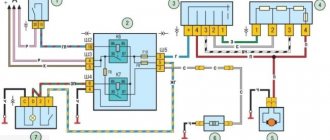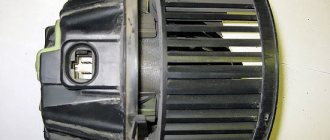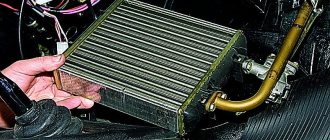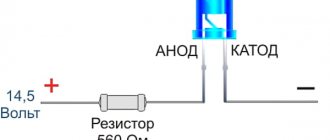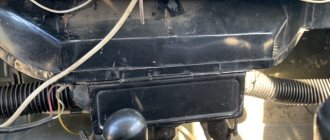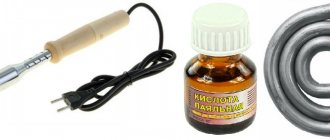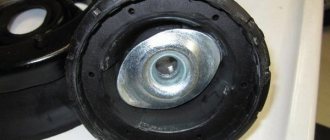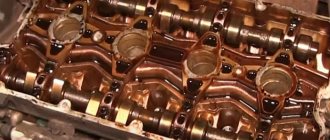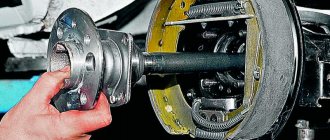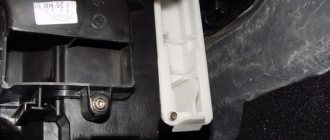If only fourth speed works
In cases where the motor refuses to work at the first, second and third speeds, but turns perfectly at the fourth, the same resistor with three isolated windings is to blame. If you can’t buy it, you can try to restore it yourself. True, only in the case when the thermal fuse has blown, naturally, no one will rewind the windings, the game is not worth the candle.
Fan resistor
You can remove and check the resistor without dismantling the engine. This is done like this:
- Use a Phillips screwdriver with a short blade to unscrew the rightmost screws securing the glove compartment.
- We gain partial access to the motor, but this is enough to get to the resistor.
- Remove the terminal block and move the wiring harness to the side.
- Using a Phillips screwdriver, unscrew the screw securing the additional resistor.
- We remove the resistor from the housing.
- We check the integrity of the thermal fuse with a multimeter. If it is faulty, you can try to replace it.
- Installation of a new or restored resistor is carried out in the reverse order.
Built-in fuse
To replace the built-in thermal fuse, any type KSD-160 or RY01-165 is suitable. They work up to a temperature of 150-165 degrees. To solder a new resistor, be sure to use low-melting solder so as not to overheat the part, and during soldering, hold it with thick pliers for better heat dissipation. Good luck to everyone and a comfortable temperature in the cabin!
Symptoms of a problem
The simplest situation is when the electric motor does not spin at all. In this case, there may be several reasons:
- Failure of fuse No. 18 with a nominal value of 25 A. It protects only the heater motor circuit.
- Break, short circuit, damage to the motor winding.
- Lack of contacts on the motor power supply block, damage to the wiring.
- Damage, freezing or wear of the electric motor brushes.
- There is no voltage at the output contacts of the speed switch, the switch is broken.
Connection diagram for the electric motor of the heater fan and the rear window heating element: 1 – ignition switch; 2 – mounting block; 3 – heater motor switch; 4 – additional resistor; 5 – heater electric motor; 6 – rear window heating element; 7 – switch for heated rear window with control lamp; A – to power supplies; K6 – additional relay; K7 – relay for turning on the heated rear window.
Stove fan repair
It is more difficult when the engine turns, but does not develop sufficient speed. This is dangerous because when the rotation of the electric motor shaft is difficult, it consumes much more current, so the fuse may burn out and the winding may fail. Diagnosing a fault in this case requires some experience and the breakdown may not be immediately detected, but a blown fuse will make it clear that there are problems with the motor.
In addition, insufficient motor speed can be caused by an interturn short circuit in the armature winding or wear or clogging of bushings or bearings. It is also possible that the cabin filter is clogged. In the case of bearings or bushings, the engine will make noise during operation, and the noise will increase over time. This can be treated either by replacing the motor, or by lubricating or replacing bushings or bearings.
The cause of increased noise from the stove may be clogged bearings and bushings that need to be lubricated.
The bushings or bearings are lubricated only with a regular spindle and machine oil. Engine oil or grease is not used in this case. A new engine costs about 600 rubles, depending on the manufacturer.
Interior heater repair
The stove in the Chevrolet Niva is considered one of the most reliable components of the car. However, it can sometimes fail.
Replacing the heater cable
Sometimes it is not possible to change the position of the heater damper. The reason for this is a broken cable. To replace it, you will need a standard set of tools and a headlamp. Replacing the cable is carried out as follows.
- The driver's seat moves back.
- The handles are removed from the damper control panel and the screws are unscrewed.
- The panel is dismantled on the left side at the location of the driver's feet.
To access the cable you will need to remove the heater control mechanism
Using a cable, the position of the air supply flap is changed
Replacing the interior heating control unit
A faulty control unit can also cause the interior heating system to not operate correctly. Its dismantling, necessary for repair or replacement, requires the following procedure.
- The negative terminal is disconnected from the battery.
- All handles are removed from the heater control mechanism. To do this, you need to carefully pull them towards you.
All handles are removed from the heater control mechanism
Use a flat screwdriver to remove the air circulation lever
Use a screwdriver to pry up and then remove the block lining
Two self-tapping screws are unscrewed under the cladding
The connector with wires is removed from the control unit
After dismantling, the control unit is repaired or replaced with a new one.
Replacing stove pipes
If a coolant leak is detected, the pipes along with the clamps should be replaced. The work is performed in the following sequence:
- The coolant is drained from the system.
- The screws securing the glove compartment are unscrewed and it is removed.
- Use a Phillips screwdriver to unscrew the clamp of the lower pipe. The hose is removed carefully - the antifreeze should not get on exposed skin. If difficulties arise, the pipe should be rotated around its axis.
- The second pipe is removed in the same way.
- New hoses are installed and tightened with clamps.
If antifreeze leaks, the stove pipes are replaced with new ones.
Video: dismantling the stove pipes on a Chevrolet Niva
Replacing the stove fan
If the fan does not turn on or if strange noises appear when it is turned on, then the electric motor is most likely faulty.
Before removing the heater motor, you need to make sure it is faulty.
The most common reasons for its failure are:
- Lack of voltage on the electric motor due to poor contact.
- Visible damage to the motor wires due to chafing.
- The 25 A fan fuse located in the fuse box number F18 has failed.
- Failure of one of the resistors, manifested in the absence of one of the speed modes.
- No ignition.
- Deterioration of the armature and brushes of an electric motor as a result of long-term continuous operation.
How does the Niva Chevrolet heater fan work?
Like any automobile electric motor, the heater fan on the Chevrolet Niva is a DC commutator motor with the ability to stepwise adjust the speed. A motor with catalog number 2123-8118020 with a removable impeller on bushings is installed on the conveyor; however, there is an alternative to it on floating bearings from the Luzar company with catalog number lFh-01211, and there is a similar bearing motor from the Boutler company.
Stove fan.
The stock engine can peak at 3,000 rpm, while the equivalents rev to a maximum of 2,750 rpm. The maximum current consumption for the Luzarov motor is 25 A, for the native one - about 18 A.
Heater motor luzar lfh-01211 12V/14A.
Additional resistor
The operation of the electric motor in four modes is ensured by an additional resistor, which often causes various malfunctions. Its catalog number is 2111.8101012 or 2123-8118022-01.
Additional resistor 2123-8118022-01.
At the first speed, the engine should consume no more than 5.1A, at the second and third 9 and 14 A, respectively. At the maximum, fourth rotation speed, the voltage is supplied bypassing the resistor. Actually, all possible culprits for the malfunction of the air supply to the cabin are indicated; it’s time to name the symptoms of the malfunction.
Refinement of the heating system of the Chevrolet Niva
When the intensity of supply of air heated by the heater into the cabin decreases, it becomes necessary to modify the heating system. This is due to errors in the assembly of the system. The main problem is the lack of tightness in the air ducts and dampers. This leads to incorrect distribution of warm air throughout the cabin. The modification is carried out as follows.
- The steering column casing and driver's side console are removed.
- On the heater side, a plate is removed that sets the direction of air supply.
The die located on the heater side needs improvement
To give the desired trajectory of movement of the damper, you can glue a plastic card to the die
The last stage of modification of the stove is the rigid fixation of the lower damper
As a result, warm air will be distributed throughout the cabin strictly in accordance with the position of the flow direction regulator.
Thus, even an inexperienced car enthusiast can ensure a comfortable microclimate in the interior of a Chevrolet Niva car. To do this, you just need to strictly follow the instructions and recommendations of professionals.
I've read horror stories about removing the front panel to lubricate/replace the heater fan. I decided to try it through the glove compartment. The stories of experienced people about this method of removal/installation were vague and undetailed. I just couldn’t figure out what was stopping the fan. After unscrewing a bunch of different plastics, this picture was revealed. https://bestpics.ru/full/IMG_1202.jpg[/img]]
Everything else is not difficult and basically comes down to working with a screwdriver.
At the same time, I combined the procedure with replacing the cabin air filter (which will greatly determine whether or not there will be wind in your feet in winter) and cleaning the insides of leaves and other nasty things.
After freeing all the fixed elements, it turned out that what was preventing the fan from being removed was a thick, thick layer of sound insulation. He was mercilessly cut in the right place in the shape of the letter “P” and bent back. Then the motor with the fan fell out inside the cabin after light pressure with a finger.
The freed unit was sent for washing and lubrication (by the way, no traces of the factory grease were found AT ALL! Dry and clean.) I wanted to lubricate it with a practical graphite lubricant just intended for such mounts. But I was afraid that it might get on the conductive components of the engine - graphite conducts current. I smeared it with love and tenderness with a thick layer of Litol-24 (I didn’t find anything else in the garage).
I assembled everything in the reverse order, straightened out the sound insulation and sealed the surgical incision with tape. The entire procedure, with an intermediate tea party, took about 1.5 hours of leisurely work in a warm garage. Turned it on. Oh, music! The fan even became quieter, not to mention the disappearance of the piercing howl.
While enjoying comfortable trips in their own car, some owners let down their vigilance excessively, not noticing the “news” sent by their “iron friend”. It is with their help that the vehicle seeks to notify the owner about the occurrence of a technical malfunction. Experienced car owners strongly recommend not just starting the engine, but listening to how it works, not just turning on the heater and waiting for warm air to flow, but again listening to see if there are any third-party sounds. If you notice warning signs, we recommend that you roll up your sleeves and fix the problems that have arisen, without waiting for the moment when they increase a hundredfold.
We remove the fan with our own hands on a Niva Chevrolet
When the cause of the fan malfunction is established, it will need to be removed from the car. Before starting work, you need to disconnect the negative on the battery (the ignition in the car must be turned off).
Disconnect the negative terminal.
To make the work more convenient, you must first remove the dashboard from the interior. Next you will need to disconnect the inlet pipes on the stove. Then you should check with your hand that the impeller can be easily rotated.
We remove the glove compartment, unscrewing everything that will interfere with us.
Then you need to disconnect the connector on the motor. If the motor does not work in only one position, you should simply replace the board.
Disconnect the fan power supply and rubber hoses.
Removal process:
- Press out the locking lugs using a screwdriver.
- Rotate the heater housing.
- In this way, bring the motor to the middle of the dashboard and pull it out completely.
Next, you need to inspect the air ducts for damage. They may contain foreign elements. Clean the air ducts. Then you should check the operation of the motor itself. To do this, you can connect it directly to the battery.
Replacing the stove fan
The connection board must be screwed to the new unit. Then insert the motor into place and turn it to the left.
We install the fan with the motor, turning it as shown in the figure.
Connect the wires and pipes to the stove to the bar. Check the operation of the engine with the ignition on. At this point the work can be considered completed.
We screw the fan, connect the wires, a rubber hose and check the functionality.
How to understand that the heater motor on a Niva Chevrolet is faulty?
On Niva Chevrolet cars, the heater is turned on from inside the car using a regulator located on the dashboard.
It has four locking positions, one position is responsible for turning off, and the rest for the air blowing speed. Therefore, if when you turn it on, there is no air blowing, or extraneous sounds are heard, this will indicate that the device at least requires maintenance.
Causes of motor malfunction
The main reasons why the stove motor fails include the following:
- There is no power to the device . This may be caused by a lack of contacts or a problem with the battery.
- There is damage to the motor wires ; due to their location in a niche, they may be subject to chafing.
- The fuse has blown . This could happen if a current of the largest value from the standard passed through the circuit. It is in the 25A standard. Number F18.
- The preliminary resistance has failed . A similar problem manifests itself in the fact that the stove will not work in one of the speed modes.
- Problems with ignition . This fact should also not be excluded, because the stove only works when the ignition is on.
- The motor and its drive shaft are worn out due to long-term operation of the device.
In any of the above cases, in order to understand what happened to the motor, it is necessary to dismantle it.
The electric motor of the interior heater fan on a Niva Chevrolet car is removed for repair or complete replacement. To carry out repair work, prepare a standard set of tools, turn off the power to the car by disconnecting the minus terminal from the battery and perform the following sequence of actions:
- Dismantle the glove box.
- We disconnect the block with the power wires from the fan electric motor.
- Next, disconnect the air supply hose.
- Using a screwdriver, unscrew the three screws securing the fan motor and remove it along with the impeller.
- Remove the retaining ring and impeller from the shaft.
- Carry out the necessary repairs or replacements, then reassemble and install the engine in the reverse order.
Step-by-step procedure for dismantling the stove motor
The stove motor is not so easy to get to!
Before we begin dismantling the stove, we prepare all the necessary tools and make sure that the key is not inserted into the ignition switch. To make it easier to dismantle the stove motor, the manufacturer recommends dismantling the entire dashboard, along with the instrument panel, wiring and other fasteners, followed by their dismantling and removal from the interior
However, we consider this method to be too long and not rational, because it is much simpler and easier to dismantle the motor simply by looking from below
To make it easier to dismantle the stove motor, the manufacturer recommends dismantling the entire dashboard, along with the instrument panel, wiring and other fasteners, followed by their dismantling and removal from the interior. However, we consider this method to be too long and not rational, because it is much simpler and easier to dismantle the motor simply by looking from below.
- So, to do this, we dismantle the glove compartment, otherwise there is no way to get the engine out of the seat.
When dismantling, we must be careful.
Remove the air duct on the right side and the power plug on the motor body itself. Next, using a Phillips screwdriver, unscrew the three screws connecting the motor to the impeller.
Then, using long flat screwdrivers, insert them in the center and separate them from each other
(When carrying out this work, pay special attention to the position of the pulley stopper and the impeller, because it can simply fly out - approx.).
Or, if you do not want to disconnect the motor from the impeller, you can unscrew the four screws in the air intake and remove the entire assembly.
Next, we remove the entire structure and begin to inspect it.
Inspection of the stove motor and replacement
We inspect the motor and impeller for damage.
Depending on the presence of certain malfunctions, the stove motor may need:
- Cleaning and blowing the impeller from dirt and dust.
- Lubricate all moving parts to avoid heat and unnecessary friction.
- Replacement of power wires or rubber pipe.
In order to diagnose the condition of the motor, you just need to bring its terminals (red and black wires directly to the battery - approx.). And if the motor is working, it will turn on at maximum power.
How the heater and cooling fan works in Niva Chevrolet
The movement of air through the heater radiator is carried out by a DC motor. The impeller is installed directly on the rotor shaft, which minimizes power losses. The fan electric motor is securely mounted in a sealed casing, which is located under the windshield of the car, so to repair it, you will need to remove some interior elements.
The operation of the electric heater motor is controlled from inside the car using a special switch.
Additional resistor
To ensure a comfortable temperature inside the car, it is not always necessary to operate the fan motor at full power. To reduce the speed, additional resistance is installed in series in the electrical circuit. This simple but effective method can significantly reduce the intensity of the air flow.
For more precise adjustment, the resistor has 3 resistance values, and given the possibility of direct connection, the rotation of the motor rotor can be set in 4 different speed modes.
The standard product provides the following indicators of the current that is directed to the electric motor after passing through the internal spiral of the limiter:
- 5.1 A – first speed.
- 9.0 A – second.
- 14.0 A – third.
DIY troubleshooting
If the Chevy Niva cooling fan does not turn on, then if you have at least a little experience, you can try to fix the problem yourself. The main advantage of repairs without the involvement of third-party specialists is saving money and time. Also, during the work, other elements and devices that are located at the location of the stove can be checked.
The disadvantages of self-repair may include making serious mistakes, which will lead to failure of not only the products being repaired, but also related parts. In some cases, replacing parts may result in a short circuit and fire in the vehicle.
If, despite all the possible disadvantages, you decide to repair the Chevrolet Niva yourself, then the recommendations below will help minimize the risks and possible damage from unprofessional intervention in the electrical system of the car.
Step-by-step instruction
If the stove fan does not turn on, then first you should check the fuse that is responsible for the safety of the wiring circuit of this electricity consumer. The Chevrolet Niva relay and fuse mounting block is located under the steering column. To get to it, you will need to unscrew the screws and remove the cover by pulling it towards you.
The location of the fuses inside the block may vary significantly depending on the car model, but in both old and restyled models, the protective device located in cell F18 is responsible for the heater heater. Such a product must operate at a current strength of more than 25 Amperes. You can check the functionality of the fuse with a tester or multimeter.
If the fuse is in good condition, the heater fan malfunction may be caused by a failed electric motor. To make sure that this part has actually burned out, you will need to dismantle it.
This work is performed in the following sequence:
- Remove the glove compartment. To perform this operation, you will need to unscrew several screws, remove the cover stops and the side casing.
- Unscrew the screws securing the electric motor.
- Disconnect the wires.
- Open the hood and remove the windshield wipers and the panel underneath them.
- Remove the cabin filter.
- Unscrew the four nuts holding the air duct box in place.
- Remove the engine from the engine compartment side.
You can check the electric motor using a multimeter, or by directly connecting it to a 12 V power source. If the motor is faulty, it must be replaced with a new original product or its complete analogue. Otherwise, it is recommended to lubricate the bearing and reassemble the interior heating system in the reverse order of removal.
If the heater fan motor constantly runs at maximum speed, then the additional resistor is most likely faulty. As a rule, this part cannot be repaired and you will need to use a new product in order to select the operating mode of the stove. To replace this part, you will also need to dismantle the glove compartment as described above.
Once this part is removed, the work of replacing the resistor is performed in the following sequence:
- Remove the wire terminal block.
- Unscrew the screw securing the resistor.
- Remove additional resistance.
- Install and connect a new product.
- Connect the wires.
- Install the glove compartment.
Sometimes the cause of a fan malfunction is a broken motor operating mode switch. The work to resolve this issue is similar to the steps above. If no broken wires are detected, this part is removed and then checked with a multimeter. Even if there is no closed circuit in one of the modes, it is recommended to replace the part.
The duration of operation of the electric motor or other components will depend on the quality of the spare parts used, so it is advisable to use only trusted retail outlets or order parts directly from the manufacturer.
Main stove malfunctions
Stove malfunctions can be very different. The most common reason for its failure is:
- heater valve malfunction;
- damage to radiator pipes;
- failure of the additional resistor;
- radiator damage;
- control unit problems.
As a result of any of the above situations, the stove stops working normally.
Warm air does not enter the lower part of the cabin
Before repairing the stove, you should check the temperature of the coolant (coolant). Perhaps the problem is not in the interior heater, but in the cooling system. If the engine warms up to operating temperature (90˚C), then the cause of the malfunction should be sought in the stove.
With the help of damper position regulators, warm air is directed to different parts of the cabin
The dampers should be adjusted first. To supply hot air to your feet, follow these steps:
- The engine warms up until the warm air can be felt with your hand.
- The heater fan speed switch is set to position 4.
- The airflow direction knob turns to the 12 o'clock position and immediately returns to 10 o'clock. Air should begin to flow into the lower part of the cabin.
- If the result is not achieved, the procedure is repeated.
This sequence of actions is due to assembly errors. Due to gaps and backlashes, interference is created with air distribution and installation of the damper in the desired position the first time. If after these steps the heat still does not reach your feet, the heating system needs to be modified.
Antifreeze leak from the stove
In used cars, coolant often begins to leak from the stove. The reason for this is usually wear and tear on the pipes or a malfunction of the heater tap. Since antifreeze circulates under pressure, all connections must be tight. However, during prolonged use, hoses and gaskets lose their elasticity and burst. After inspecting the heating system and identifying the leak, the worn part is replaced with a new one. When making repairs, you should not use clamps made in China due to their poor quality.
Problem
The question, as always, turned out to be extremely simple - the quality of the original delivery. It turned out that the Chevrolet Niva heater motor was supplied to the conveyor assembly assembled from the Kaluga plant. The official name of PJSC Kaluga Automotive Electrical Equipment Plant is KZAE. This plant, as you know, is almost entirely configured to work with the Volkswagen plant, which is located there, and supplies products to AvtoVAZ only for the assembly line. And even these supplies are not enough and we have to install stove motors from other manufacturers. There is a very big difference, both in the resource of spare parts and in the ease of installation. Of course, the main supplier of the Russian spare parts market is China or Luzar (which is not very important). The motors initially hum very loudly, but most importantly the impeller is pressed onto the motor shaft. While on the Kaluga product it is located on a lock washer, which greatly facilitates the installation and dismantling of the spare part. There is another Tolyatti product, if I’m not mistaken, of a similar design. But with a minimal difference in price, it is better to supply a conveyor original, especially since, as I said earlier, the plant serves Volkswagen.
Important nuances
There are several important points that must be taken into account when changing the heater fan on a Chevrolet Niva. Here they are:
The cabin filter cover should be removed very carefully, since the latches that hold it in place are easily broken. This point is especially relevant if you have to change the fan in the cold;
when lowering an unscrewed electric motor, you should remember that there is a small guide bushing on its shaft, which is very easy to lose: it falls, rolls down the glove compartment directly into the engine compartment and it will be very difficult to find it there;
It is not always possible to find a “native” fan for a Chevrolet Niva on sale (its catalog number is 21238118020)
For this reason, many car owners install LUZAR brand fans (and its number is lFh01211). These devices cannot be called a good alternative, and here's why. “Native” fans for the Chevrolet Niva can rotate at a speed of 3000 rpm, while the analogue from LUZAR reaches a maximum speed of 2800 rpm. The “native” fan consumes a current of only 18 A, and the LUZAR consumes 25 A. At the same time, fuse F18, mentioned above, is designed for 25 A, that is, the risk of its burnout when using the LUZAR fan increases many times over. In such a situation, the best option would be to install a “native” fan on the Chevrolet Niva.
Replacing a broken fan on a Chevrolet Niva is not that difficult. Even a novice car enthusiast who has held a Phillips-head screwdriver at least once in his hands can cope with this task. The main thing is not to damage the latches on the cabin filter cover and not to lose the fan guide bushing.
Replacing the heater fan on a Chevrolet Niva
Before you start work, you need to stock up on everything you need. Here's what we need:
- hex keys, set;
- Phillips screwdriver;
- new heater fan.
Replacement sequence
- The hood of the Chevrolet Niva opens. Near the windshield there is a niche with a cabin filter installed in it, which is covered with a plastic cover with latches. They are opened manually, the cover is removed, and then the cabin filter is removed. Access to the furnace fan impeller is provided.
- There is a mounting bracket on the impeller. Use a Phillips screwdriver to loosen the bolt that holds it, the bracket is moved to the side and removed.
- The car interior opens. Using the same Phillips screwdriver, unscrew the screws holding the glove compartment panel. The glove compartment is removed. Now you have access to the electric heater motor.
- The electric motor is held on by three self-tapping bolts. They are unscrewed using a 10mm hex.
- After unscrewing the last screw, the electric motor is carefully lowered (no problems should arise, since the mounting bracket has already been removed from the impeller).
- When the electric motor is removed, the fan impeller is completely freed and can be removed through the cabin filter niche.
- The old impeller is replaced with a new one, then all components are assembled in the reverse order.
Fan replacement
So, if there is an urgent need to replace the stove motor, we recommend that you hurry with the repairs without waiting for frost. Believe me, driving in a vehicle in which the heating system does not function is quite uncomfortable. In addition, in severe frosts such trips are still extremely unsafe, since the lack of heat does not allow the ice concentrated on the windows to thaw. Icy windows limit the driver's visibility of the roadway and, accordingly, provoke emergency situations.
New working stove fan
So, pick up a new fan and check the quality of rotation of the blades. If you have not purchased it yet, we recommend that you give preference to a model with bearings, of course, if the auto store offers you an expanded range of heaters suitable for your Chevrolet Niva.
Replacement algorithm
Now that you have already prepared for the immediate replacement, we recommend that you familiarize yourself with the algorithm of actions. By the way, on some forums you can find advice from car owners, which indicates the need to completely remove the entire panel. On other forums you will easily find an alternative opinion, which we also adhere to. You can dismantle the old stove fan on the Niva, and then successfully install a new motor in the same way, without resorting to complete dismantling of the panel. It is quite possible to get by by removing the glove compartment and air duct. Don't neglect one more piece of our advice. Purchase a new cabin filter in advance. You will not incur serious financial expenses, but at the same time you will make the operation of the heater easier, and also eliminate the urgent need to replace a dirty filter in the near future.
The process of disassembling the glove compartment with removing the heater fan
Unscrew all the bolts holding the glove compartment, remove it, then remove the cabin filter. After this, you will find a fan that you need to dismantle and then replace. You will find a latch on the impeller; we advise you to press it, and then unscrew the three screws that directly secure the electric motor. We recommend that you be patient and persevere, as these actions will not be easy for you. It is very inconvenient to get to the places where these screws are located. If you have screwdrivers with a small handle, then it will be more profitable for you to use them directly.
As soon as you manage to unscrew the screws, the fan will immediately begin to slide. You need to hold it, but at the same time shake it slightly in different directions, which will allow you to pull it off the shaft. As soon as it is in your hands, consider that you have already done half of the work.
Faulty heater fan motor
We now set you up for the preparatory work ahead of installing your new fan. Examine the motor carefully. During such a visual inspection, you will easily find holes on the surface of the impeller. Pull a wire with a thin cross-section through them, then secure it in the shaft where the motor should be placed. Make sure that the impeller “becomes” correctly. In particular, the groove located on its surface must fit into the pin on the motor shaft. In addition, the impeller must be located perpendicular to the axis of your car.
It's time to install a new fan. We recommend lubricating it and only then installing it. By the way, this procedure is quite complicated due to the fact that although all the actions are understandable, it is inconvenient to perform them. Twist and turn your new fan, do whatever you want, as you please, only the electric motor must be in the right place. Once you are sure that you have actually positioned the fan correctly, you can proceed to secure it by tightening a few screws securely. Now don't forget that you have a wire connected. Of course, the moment has already come when you no longer need it. Get to it through the engine compartment, bite it off and remove it. The last final step is to connect the pipes. Now that you have so diligently completed everything that we recommended to you, you can check the result of your work. Start the engine, warm it up, and then observe how well your heater and fan work.
So, the work associated with replacing a fan is not so much complicated as it is extremely inconvenient. However, if you love your car and are determined to do everything yourself, then your replacement will be as successful as possible. Just be sure to strictly follow the algorithm we have proposed.
Source
Replacing the heating fan fuse
As mentioned above, almost any malfunction of the stove motor disables fuse F18. It is installed in the safety block, which is located to the left of the steering column, directly above the driver's left knee. The block is covered with a plastic console, so you will need a Phillips screwdriver to work.
Sequencing
- The plastic console of the fuse box is held in place by two self-tapping screws. They are unscrewed with a Phillips screwdriver.
- Now the console is carefully bent down until its lower edge is disengaged (the edge of the console is held in place by a plastic latch and a characteristic click will be heard when it opens).
- After removing the console, fuse F18 is removed from its socket. Its location is shown in the photo below.
- The fuse is inspected. If it fails, the insert in its body will be torn and melted. The fuse housing itself will most likely also be melted and traces of soot will be visible on it.
- The blown fuse is replaced with a new one, and the console is returned to its place.
How to remove and replace a fan
Many people wonder: replacing or repairing a Chevrolet Niva heater fan can happen through the glove compartment. Of course, repairs can. However, the replacement can be done in other, easier ways. First you need to figure out how to remove the heater. First you need to disconnect the negative on the battery. Next, the action plan is as follows:
- First you need to remove the dashboard from the interior;
- then you need to disconnect the connector on the motor;
- if the previous action cannot be completed, then the board should be replaced;
- Next you need to press out the locking lugs with a screwdriver;
- rotate the heater housing;
- bring the motor to the middle of the panel and remove it;
- After this, you need to check the device for damage.
If the heater is worn out and needs to be replaced, then the process of installing a new unit will consist of the following steps:
- The connection board is first screwed to the new device.
- Then insert the motor into place and turn it well to the left.
- Once it is in the hole, it must be stopped so that it does not move.
- After this, you need to connect the wires to the bar, and the pipes to the stove.
- Next, you need to check how the motor functions when the ignition is on.
Even a cleaning motorist can handle an air conditioner or heater. It is enough just to know how the parts are arranged and what they are connected to. Then you can start working sequentially. The main thing is not to rush, but to act harmoniously and carefully.
I have an air conditioner, it does not interfere with the removal and installation of the motor.
how to change the heater motor on a Chevrolet Niva
You can't do it alone without a rope.
Recently, we have to use a heater more and more often in the interior of a Chevrolet Niva car,…
There is very little space here, so I recommend stocking up on a short Phillips screwdriver in advance, this way you will save your nerve cells. Next you need to prepare the impeller for installation.
The book says that you need to remove the entire panel and only then replace it, but on the forums they write that you can get by, which is what I did. I started with access to the air intake into the cabin. In general, the eyes are afraid, but the hands do.
If it fails, the insert in its body will be torn and melted. The fuse housing itself will most likely also be melted and traces of soot will be visible on it.
Here's what we need: Near the windshield there is a niche with a cabin filter installed in it, which is covered with a plastic cover with latches.
They are opened manually, the cover is removed, and then the cabin filter is removed.
Access to the furnace fan impeller is provided. Use a Phillips screwdriver to loosen the bolt that holds it, the bracket is moved to the side and removed.
If the motor is initially slow, it is better to look elsewhere. By the way, my dear, after I lubricated it with lithol, plowed it for six months in silence.
Next, you can immediately buy a cabin filter - when will we get there again? A light source wouldn't hurt either.
How to determine if the heater motor is faulty
In a Chevrolet Niva, the heater is turned on inside the car. This is done using a regulator located on the dashboard (dashboard). The regulator has four positions, three of them are responsible for the operation of the stove and fan in different power modes, and the fourth is switching off. When switching the regulator to position 1, if the motor malfunctions, the sound of the fan will not be heard. This indicates that the motor is not working. It is necessary to click through all three positions with the regulator, and if the motor does not turn on in any of them, then this means that it has failed.
The main reasons for the heater not working in a Chevrolet Niva include the following problems:
- No battery power. The battery is faulty or there is no ground on the vehicle.
- The heater motor power wires are damaged.
- The fuse has blown due to the passage of a large current.
- The pre-resistance is faulty. In this case, the motor will not work in all modes.
- The car's ignition is not turned on. The stove in the Chevrolet Niva only works when the ignition is on.
- The heater motor has worn out and needs to be replaced with a new one.
The procedure for removing the old motor and replacing it with another
Having determined the cause of damage to the heater, it is necessary to remove the worn motor. First you need to disconnect the negative terminal from the battery. When disconnecting the ground from the battery, you must make sure that the car's ignition is turned off. Otherwise, you risk the possibility of failure of the injection control unit, which will lead to serious repair work.
Armed with the necessary set of tools, you can begin to remove the motor. To make it easier to dismantle the motor, it is necessary to remove the dashboard from the car interior. After this, it is necessary to remove all the inlet pipes suitable for the fan and check the ease of movement of the fan impeller itself. Not wanting to remove the dashboard, you can crawl underneath and try these operations. It is necessary to remove the glove compartment, since it will not be possible to remove the motor otherwise. After this, you need to disconnect the right air duct and the plug on the motor housing. If the motor does not work in only one position, but works in the others, then only the board needs to be replaced. The motor is removed as follows: the locking lugs are pressed down using a screwdriver, and the heater housing is turned clockwise, after which the motor is brought to the middle of the instrument panel and removed.
After removing the motor, it is necessary to inspect the air duct. Foreign objects or particles may have gotten into it and need to be removed and the air duct cleaned of dust. You can check the functionality of the removed motor by connecting it directly to the battery terminals. If the cause of the heater malfunction is in it, then you are on the right track to repairing the stove.
Installing a new motor
To do this, you need to take a new motor and screw on the connecting board. After this, insert the motor into place and turn it to the left.
Connect all inlet pipes and install everything in its place. When finished, check the motor for functionality by connecting the terminal to the battery. If the motor hums, then its replacement was completed correctly.
Determining the malfunction of the stove fan
The stove in the Niva Chevrolet is turned on from the passenger compartment. The regulator is located on the dashboard. It has four positions . Three of them are designed to switch the operation of the heater in different power modes. The fourth is used to turn on the electric motor.
The heater fan turns on in the fourth position.
When you put the regulator in position “1” , the sound of the motor will not be heard if it is out of order. Also, its operation should be checked in all other positions. If it doesn't work, it will have to be replaced.
Main causes of problems:
- No battery power.
- The power supply cable to the fan is damaged.
- The fuse has failed.
- The pre-resistance is faulty. In this option, the fan will not work only in some positions.
- The ignition is not turned on.
- The fan has reached the end of its service life. It needs to be completely replaced.
Due to problems with the wiring and winding, the stove fan melted the impeller.
Signs of malfunction of the Chevrolet Niva heater fan
There are several typical signs by which a driver can understand that something is wrong with the fan. Here they are:
- the fan does not rotate. It’s impossible not to notice this, because the car’s interior suddenly becomes unusually quiet. This problem occurs when fuse F18 in the safety block, which is responsible for the electrical circuit of the fan motor, fails. In addition, the winding on the fan motor itself may be damaged. For example, the insulation on it may be broken, after which the adjacent turns short-circuit;
- reducing fan speed. It is much more difficult to notice such a malfunction. With this breakdown, the electric motor of the stove continues to work, but not at full power. An experienced driver with good hearing will understand that the heater fan has begun to make a different noise. This means that the rotation of the shaft is greatly hampered by worn brushes or a commutator. The problem is that a motor with such a breakdown consumes more current. And this, in turn, can damage fuse F18;
- fan creaking. It occurs when the bearings in an electric motor wear out. Moreover, as the bearings deteriorate, the creaking gradually increases, turning into a grinding sound. If the driver does nothing, the fan will simply stop and fuse F18 will burn out. In the event of this breakdown, the car owner will have to replace the entire electric motor, since it is not possible to find bearings for it on sale.
